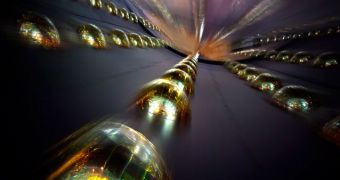Physicists with a multinational collaboration announce that they were recently able to measure the last unknown mixing angle of elementary particles called neutrinos with extreme precision. The work may open a new way of analyzing particle physics.
As their names imply, neutrinos are electrically-neutral elementary particles that travel at nearly the speed of light, and can pass through solid objects unaffected by the force of gravity. Trillions have passed through you since you began reading this article.
Due to their unwillingness to interact with normal matter, physicists have been having a hard time detecting and analyzing neutrinos. The Daya Bay Reactor Neutrino Experiment was set up in southern China in order to facilitate this effort.
One of its main directives was to figure out how neutrinos appear to vanish as they move, and then simply reappear farther down the line. The conclusions researchers at Daya arrived at may finally explain why we exist at all.
During the Big Band, equal amounts of baryonic matter and antimatter were produced. By all accounts, they should have canceled each other out. As evidenced by our very existence, this did not happen, and astrophysicists have been trying to figure out why this is for decades. The research may help with this.
Neutrinos exist in three types called flavors. These are electron, muon, and tau neutrino. As they travel through space, these flavors constantly interact with their corresponding antineutrinos, mixing and oscillating in a manner that makes them nearly impossible to detect.
During their latest study, the Daya investigators determined how electron neutrinos and their antineutrino counterparts mix and change into the other flavors. This process is called theta one-three (written θ13), and represents the last mixing angle of neutrinos that researchers did not fully understand.
“This is a new type of neutrino oscillation, and it is surprisingly large. Our precise measurement will complete the understanding of the neutrino oscillation and pave the way for the future understanding of matter-antimatter asymmetry in the Universe,” expert Yifang Wang explains.
He holds an appointment as the Chinese project manager of the Daya Bay experiment. The scientist is a co-spokesperson for the collaboration, and is based at the Institute of High Energy Physics (IHEP).
The team explains that sin2 2 θ13 is equal to 0.092 plus or minus 0.017.
“Although we’re still two detectors shy of the complete experimental design, we’ve had extraordinary success in detecting the number of electron antineutrinos that disappear as they travel from the reactors to the detectors two kilometers away,” concludes scientist Kam-Biu Luk.
The expert holds an appointment with the US Department of Energy’s (DOE) Lawrence Berkeley National Laboratory (Berkeley Lab) and the University of California in Berkeley (UCB).

 14 DAY TRIAL //
14 DAY TRIAL //